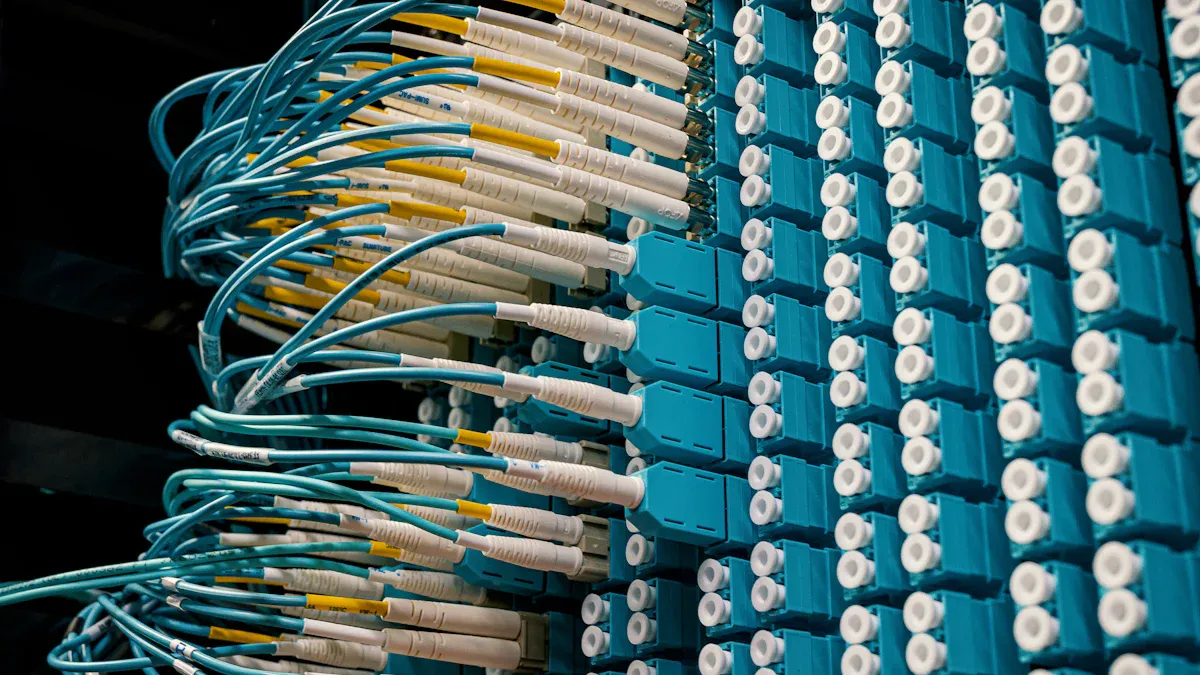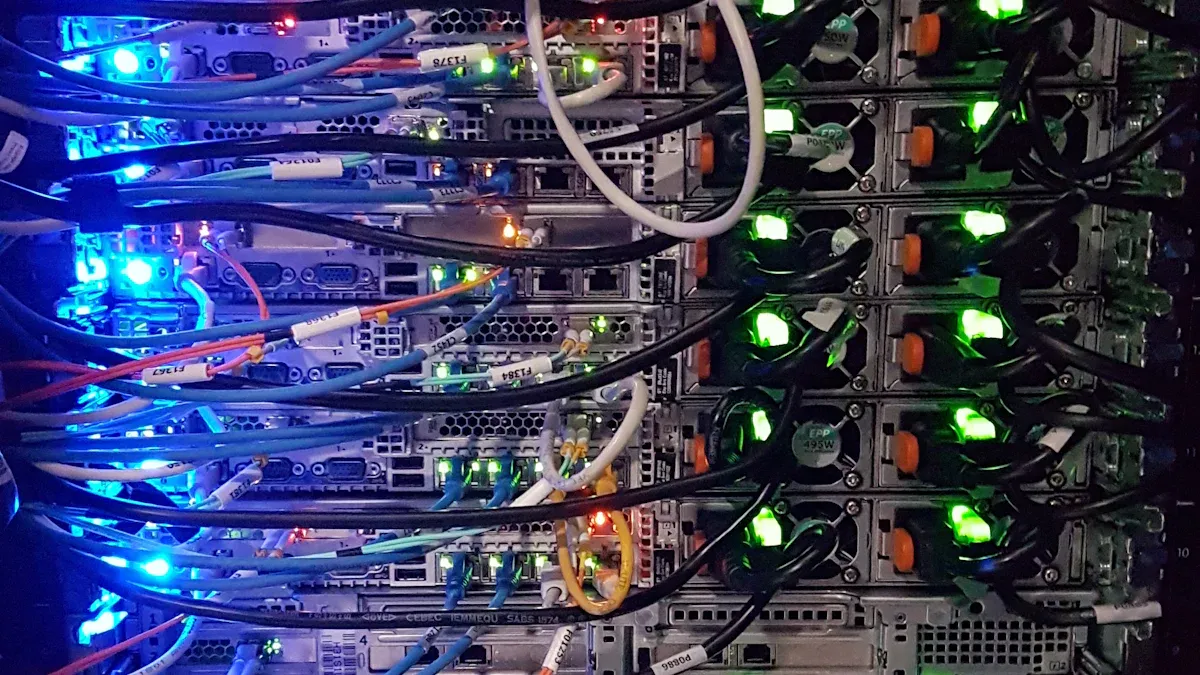Telecom Cabinet Backup Power Switching: 3 Core Indicators of Controller-Monitored Battery SOH (State of Health)

Telecom cabinet power failures often occur when battery health monitoring falls short. Controllers track voltage, current, and internal resistance to maintain reliable backup power switching. Monthly voltage and temperature tests, along with real-time monitoring, quickly detect drops or abnormal discharge rates. Predictive analytics spot battery degradation early, allowing timely maintenance and preventing unexpected outages. This approach extends battery life and ensures telecom cabinet power systems deliver consistent performance when switching is needed.
Key Takeaways
Controllers monitor battery voltage, current, and internal resistance to track battery health and prevent power failures in telecom cabinets.
Regular and real-time monitoring helps detect early signs of battery aging or faults, allowing timely maintenance and avoiding unexpected outages.
Advanced battery management systems provide continuous data, alarms, and predictive analytics to optimize battery performance and extend lifespan.
Maintaining battery health above critical levels ensures reliable backup power and reduces costly downtime for telecom services.
Proactive maintenance based on SOH data improves system reliability, lowers repair costs, and supports smooth telecom cabinet power switching.
Core SOH Indicators
Battery state of health (SOH) relies on three main indicators: voltage, current, and internal resistance. Controllers in telecom cabinet power systems monitor these parameters to evaluate battery performance and predict capacity fade.
Voltage
Voltage represents the electrical potential difference across battery terminals. In telecom cabinet power systems, controllers measure both open-circuit voltage (OCV) and dynamic voltage under load. OCV indicates the chemical state of the battery, while dynamic voltage reflects how the battery responds during operation. Typical lithium-ion batteries show an OCV between 3.0V and 4.2V. Discharge cutoff voltage usually sits near 2.5V, and full charge voltage reaches about 4.2V. Voltage readings help identify aging, temperature effects, and polarization. A drop in voltage during discharge signals reduced capacity and possible degradation.
Tip: Regular voltage monitoring allows early detection of battery issues before they affect telecom cabinet power reliability.
Current
Current measures the flow of electric charge during battery operation. Controllers track charge and discharge currents to assess battery durability and aging. In cycle testing, predefined current patterns reveal how batteries handle repeated use. Float current, a small continuous current that maintains battery charge, provides valuable SOH information. Significant increases in float current—sometimes three to six times the nominal value—can indicate thermal runaway or other critical failures. Gradual float current rises often point to aging and capacity decline.
Indicator / Pattern | Description | SOH Relevance |
|---|---|---|
Float current upsurge | Float current rises sharply over weeks | Signals thermal runaway risk |
Gradual float current increase | Float current trends upward | Indicates aging and capacity fade |
Elevated float current causes | Overcharging, grid corrosion, electrolyte drying | Accelerates degradation |
Controllers use continuous, non-intrusive current monitoring to catch these patterns early, supporting preventive maintenance and compliance with industry standards.
Internal Resistance
Internal resistance refers to the opposition within the battery to the flow of current. It consists of both DC resistance and AC impedance, which controllers measure using specialized tests. New batteries typically show resistance around 0.1Ω, but this value can double or triple after hundreds of cycles. Higher internal resistance causes greater voltage drops, reduces power output, and shortens standby time. It also increases heat generation, raising the risk of thermal runaway and complicating thermal management.
Higher internal resistance leads to more energy loss and shorter standby times.
Increased resistance causes errors in state-of-charge estimation, lowering reliability.
Lower charge-discharge efficiency results from rising resistance, reducing system performance.
Manufacturers focus on minimizing internal resistance to improve battery reliability and extend the life of telecom cabinet power systems. Capacity fade often appears as increased internal resistance, lower voltage under load, and abnormal current patterns.
Monitoring Methods

Controller Techniques
Controllers and battery management systems (BMS) play a vital role in monitoring battery health in telecom cabinet power systems. They use advanced sensors to track voltage, current, internal resistance, and temperature. These systems often rely on periodic pulsing and diagnostic signals to measure internal resistance without interrupting normal operation. Integration with modules like ABAT100-S and ABAT100-C allows for 24-hour online monitoring and supports a wide range of battery types, including 2V, 6V, and 12V cells. The collector module can manage up to 120 batteries, process data, generate alarms, and store historical records. Communication protocols such as MODBUS and CAN bus enable seamless data transfer to external monitors or SCADA systems. Many systems feature easy installation, requiring only one wire per battery, and do not need special training.
Feature/Component | Description |
|---|---|
Monitoring Parameters | Battery voltage, internal resistance, negative electrode temperature |
System Components | ABAT100-S, ABAT100-C, ABAT100-HS, ATP010KT touch screen |
Monitoring Capability | 24-hour online monitoring, detects degraded battery performance |
Battery Compatibility | Supports 2V, 6V, and 12V battery types |
Data Management | Manages up to 120 batteries, data processing, alarm generation, storage |
Integration | MODBUS protocol for third-party system connection |
Installation | One wire per battery, no special training required |
Additional Features | Remaining capacity estimation, real-time alarm, data query |
Modern BMS solutions, such as the CELLGUARD™ Wireless Battery Monitoring System, use conductance-based technology to evaluate state-of-health. These systems integrate sensor data wirelessly, reducing installation complexity and enabling remote access for continuous monitoring and proactive maintenance.
Data Trends
Continuous monitoring of voltage, current, temperature, and internal resistance helps detect early signs of battery degradation in telecom cabinet power systems. BMS analyze these data trends to forecast failures and schedule timely maintenance. Some common patterns include:
Rising internal resistance, which signals battery aging and reduced efficiency.
Voltage irregularities or fluctuations, indicating underperformance or instability.
Temperature anomalies, such as sudden spikes, which may point to overheating and accelerated degradation.
Physical changes like swelling or corrosion, which often accompany declining battery health.
Real-time monitoring and predictive analysis allow operators to identify these trends before they lead to critical failures. Logging, alarms, and relay outputs provide immediate alerts, supporting proactive maintenance and ensuring reliable telecom cabinet power delivery.
Note: Early detection of abnormal readings, such as a sharp increase in internal resistance or unexpected voltage drops, often indicates the need for battery replacement or further investigation.
Telecom Cabinet Power Reliability

Failure Prevention
Telecom cabinet power systems depend on healthy batteries to deliver backup energy during outages. Unexpected battery failures can disrupt communication services and cause costly downtime. Several factors contribute to battery failures in these systems:
Exposure to extreme temperatures, such as heat or cold, accelerates battery degradation and reduces efficiency.
Vibrations and power surges can physically damage batteries or affect their performance.
Improper installation or lack of routine maintenance leads to unnoticed damage or wear.
SOH monitoring addresses these risks by continuously tracking battery condition. Controllers detect early signs of damage or performance decline, such as rising internal resistance or abnormal voltage drops. Real-time alerts notify operators about overheating or low power, allowing prompt intervention. Predictive maintenance uses data analysis to schedule repairs or replacements before failures occur. These measures help prevent unexpected outages and maintain stable telecom cabinet power delivery.
Performance Optimization
Maintaining battery SOH above critical thresholds, typically between 70% and 80%, ensures reliable performance. When SOH drops below these levels, batteries lose capacity and efficiency, increasing the risk of failure. Controllers optimize energy use and load balancing, which prevents overloading and extends battery lifespan. Remote management and routine inspections help maintain optimal environmental conditions, such as temperature and humidity. Operators use SOH data to make informed decisions about maintenance and replacement, reducing unnecessary costs and downtime.
A well-monitored system supports consistent backup power switching and extends the operational life of telecom cabinet power systems. By focusing on SOH indicators, telecom professionals can deliver stable service and minimize disruptions.
Maintenance and Decision-Making
Proactive Strategies
Operators rely on SOH data to shape maintenance schedules and backup power switching decisions in telecom cabinet power systems. Real-time monitoring identifies faults and environmental changes, such as temperature spikes or humidity shifts, before they cause failures. Teams use predictive analytics to forecast equipment issues, allowing them to plan repairs and replacements ahead of time.
AI-enabled predictive maintenance analyzes sensor data to forecast faults, reducing emergency repairs and extending equipment life.
Real-time alerts monitor voltage, temperature, and battery health, enabling early detection and prevention of power interruptions.
Wireless power monitors and centralized portals improve operational efficiency and reduce mean time to repair.
Proper cooling and environmental controls maintain system reliability.
Maintenance teams receive training to interpret alerts and diagnostic codes for rapid troubleshooting.
Automated notifications via email, SMS, and push notifications ensure immediate response and minimize downtime.
Modular rectifier modules and integrated power components simplify repairs and reduce failure points.
Operators also identify and monitor critical components, such as diesel generators, battery strings, and HVAC units, using sensors and secure communication protocols. Centralized monitoring systems aggregate data from multiple sites, supporting efficient coordination and faster decision-making.
Actionable Insights
SOH data provides actionable insights that transform maintenance from reactive to predictive. Operators detect anomalies, such as power fluctuations or environmental hazards, and respond quickly to prevent failures. Centralized management platforms aggregate real-time data, enabling dynamic thermal management and intelligent power distribution.
Early warnings from remote monitoring tools allow operators to detect faults and respond proactively, reducing downtime and operational costs.
Regular maintenance activities, including cleaning, wiring inspections, and battery health checks, prevent failures and extend equipment lifespan. Modular cabinet designs with hot-swappable rectifier modules allow maintenance without shutting down the system, ensuring continuous operation. Advanced features, such as MPPT algorithms and thermal management, reduce component stress and lower repair costs. Optimized maintenance based on SOH data supports timely interventions, minimizes unexpected outages, and improves the reliability of telecom cabinet power systems.
Monitoring voltage, current, and internal resistance plays a vital role in maintaining reliable telecom cabinet power systems. Controller-monitored SOH indicators help operators prevent failures and optimize maintenance. The following examples highlight the impact of advanced monitoring:
Case Study Description | Impact on Power Reliability |
|---|---|
Intelligent PDUs tracked power usage at the outlet level. | Equipment uptime improved by 20%, and maintenance costs dropped. |
Predictive tools detected failures early. | Timely interventions prevented service disruptions and extended component lifespan. |
Operators should consider adopting advanced SOH monitoring solutions to enhance system reliability and reduce downtime.
FAQ
What does SOH mean in telecom cabinet batteries?
SOH stands for State of Health. It shows how well a battery performs compared to its original condition. Controllers use SOH to decide when to switch backup power and schedule maintenance.
Why do controllers monitor voltage, current, and internal resistance?
Controllers track these indicators to detect battery aging, faults, and performance loss. Early detection helps prevent power failures and keeps telecom cabinets running smoothly.
How often should operators check battery SOH?
Operators should check SOH daily using automated systems. Monthly manual inspections help confirm sensor data and catch issues that automatic monitoring might miss.
What happens if internal resistance increases sharply?
A sharp rise in internal resistance signals battery degradation. The battery may lose capacity, heat up, or fail to deliver backup power during outages.
Can advanced SOH monitoring reduce maintenance costs?
Yes. Advanced SOH monitoring gives early warnings and accurate data. Operators can replace batteries before failure, avoid emergency repairs, and lower overall maintenance expenses.
See Also
Methods To Calculate Power Systems And Batteries For Telecom Cabinets
Battery And Grid-Tied Solar Inverter Solutions For Telecom Cabinets
Solar Energy Storage Systems Designed For Telecom Cabinet Power
ESTEL’s Smart Microgrid Energy Storage For Telecom Cabinets
Complete Risk Assessment Guide For Telecom Cabinet Batteries By ESTEL
CALL US DIRECTLY
86-13752765943
3A-8, SHUIWAN 1979 SQUARE (PHASE II), NO.111, TAIZI ROAD,SHUIWAN COMMUNITY, ZHAOSHANG STREET, NANSHAN DISTRICT, SHENZHEN, GUANGDONG, CHINA

